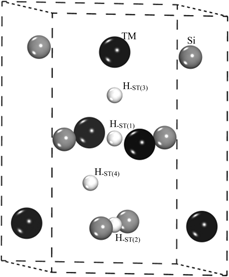Crossref Citations
This article has been cited by the following publications. This list is generated based on data provided by
Crossref.
Pan, Yong
Wang, Jie
Wang, Dajun
and
Deng, Hong
2020.
Influence of vacancy on the elastic properties, ductility and electronic properties of hexagonal C40 MoSi2 from first-principles calculations.
Vacuum,
Vol. 179,
Issue. ,
p.
109438.
Pan, Y.
and
Guan, W.M.
2020.
The hydrogenation mechanism of PtAl and IrAl thermal barrier coatings from first-principles investigations.
International Journal of Hydrogen Energy,
Vol. 45,
Issue. 38,
p.
20032.
Pan, Yong
and
Lin, Yuanhua
2020.
Influence of alloying elements on the mechanical and thermodynamic properties of ZrB12ceramics from first‐principles calculations.
International Journal of Quantum Chemistry,
Vol. 120,
Issue. 12,
Pan, Yong
Pu, Delin
and
Liu, Gaihua
2020.
Influence of Mo concentration on the structure, mechanical and thermodynamic properties of Mo–Al compounds from first-principles calculations.
Vacuum,
Vol. 175,
Issue. ,
p.
109291.
Pan, Yong
Lin, Yuanhua
Liu, Gaihua
and
Zhang, Jin
2020.
Influence of transition metal on the mechanical and thermodynamic properties of IrAl thermal barrier coating.
Vacuum,
Vol. 174,
Issue. ,
p.
109203.
Pan, Yong
Pu, Delin
Liu, Gaihua
and
Wang, Ping
2020.
Influence of alloying elements on the structural stability, elastic, hardness and thermodynamic properties of Mo5SiB2 from first-principles calculations.
Ceramics International,
Vol. 46,
Issue. 10,
p.
16605.
Pan, Yong
Pu, Delin
and
Jia, Yanlin
2020.
Adjusting the correlation between the oxidation resistance and mechanical properties of Pt-based thermal barrier coating.
Vacuum,
Vol. 172,
Issue. ,
p.
109067.
Pan, Yong
and
Chen, Shuang
2020.
Exploring the novel structure, transportable capacity and thermodynamic properties of TiH
2
hydrogen storage material
.
International Journal of Energy Research,
Vol. 44,
Issue. 6,
p.
4997.
Pan, Yong
2020.
First‐principles investigation of structural, electronic, and optical properties of transition metal‐dopedC40 CrSi2.
International Journal of Quantum Chemistry,
Vol. 120,
Issue. 22,
Pu, Delin
and
Pan, Yong
2021.
Prediction the structure, mechanical properties and melting point ofD8m‐Mo5SiB2andCmcm‐Mo5SiB2.
International Journal of Quantum Chemistry,
Vol. 121,
Issue. 18,
Lu, Yaoping
Duan, Yonghua
Peng, Mingjun
Yi, Jianhong
and
Li, Caiju
2021.
First-principles calculations of electronic, optical, phononic and thermodynamic properties of C40-type TMSi2 (TM = Cr, Mo, W) disilicides.
Vacuum,
Vol. 191,
Issue. ,
p.
110324.
Lu, Yaoping
Yang, Ancang
Duan, Yonghua
and
Peng, Mingjun
2021.
Structural stability, electronic and optical properties of MAX-phase ternary nitrides β-TM4AlN3 (TM = V, Nb, and Ta) using the first-principles explorations.
Vacuum,
Vol. 193,
Issue. ,
p.
110529.
Yu, Ende
and
Pan, Yong
2021.
Influence of noble metals on the electronic and optical properties of LiH hydride: First-principles calculations.
International Journal of Hydrogen Energy,
Vol. 46,
Issue. 71,
p.
35342.
Pan, Y.
Pu, D.L.
and
Yu, E.D.
2021.
Structural, electronic, mechanical and thermodynamic properties of Cr–Si binary silicides from first-principles investigations.
Vacuum,
Vol. 185,
Issue. ,
p.
110024.
Pu, D.L.
and
Pan, Y.
2021.
Influence of high pressure on the structure, hardness and brittle-to-ductile transition of NbSi2 ceramics.
Ceramics International,
Vol. 47,
Issue. 2,
p.
2311.
Yamusa, Shehu Aminu
Shaari, Amiruddin
Alsaif, Norah A. M.
Alsalamah, Ibtihal M.
Isah, Ibrahim
and
Rekik, Najeh
2022.
Elucidating the Structural, Electronic, Elastic, and Optical Properties of Bulk and Monolayer MoS2 Transition-Metal Dichalcogenides: A DFT Approach.
ACS Omega,
Vol. 7,
Issue. 49,
p.
45719.
Pan, Y.
and
Chen, S.
2022.
Influence of alloying elements on the mechanical and thermodynamic properties of ZrB2 boride.
Vacuum,
Vol. 198,
Issue. ,
p.
110898.
Chen, Shuang
and
Pan, Yong
2022.
Mechanism of interlayer spacing on catalytic properties of MoS2 from ab-initio calculation.
Applied Surface Science,
Vol. 599,
Issue. ,
p.
154041.
Feng, Zhiqi
Duan, Yonghua
Shen, Li
Peng, Mingjun
and
Qi, Huarong
2022.
Effects of vacancies on structural, electronic, mechanical, and thermodynamic properties of C40-VSi
2
.
Philosophical Magazine,
Vol. 102,
Issue. 15,
p.
1505.
Wang, Renfu
Yang, Ancang
Bao, Longke
Peng, Mingjun
and
Duan, Yonghua
2022.
Elastic anisotropies, electronic structures and tensile properties of anti-perovskite M3AlC (M=Ti, Co, Fe, Mn) phases: A first-principles calculation.
Vacuum,
Vol. 202,
Issue. ,
p.
111146.





